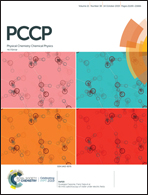Structural properties and influence of solvent on the stability of telomeric four-stranded i-motif DNA†
Abstract
Repetitive cytosine rich i-motif forming sequences are abundant in the telomere, centromere and promoters of several oncogenes and in some instances are known to regulate transcription and gene expression. The in vivo existence of i-motif structures demands further insight into the factors affecting their formation and stability and development of better understanding of their gene regulatory functions. Most prior studies characterizing the conformational dynamics of i-motifs are based on i-motif forming synthetic constructs. Here, we present a systematic study on the stability and structural properties of biologically relevant i-motifs of telomeric and centromeric repeat fragments. Our results based on molecular dynamics simulations and quantum chemical calculations indicate that along with base pairing interactions within the i-motif core the overall folded conformation is associated with the stable C–H⋯O sugar “zippers” in the narrow grooves and structured water molecules along the wide grooves. The stacked geometry of the hemi-protonated cytosine pairs within the i-motif core is mainly governed by the repulsive base stacking interaction. The loop sequence can affect the structural dynamics of the i-motif by altering the loop motion and backbone conformation. Overall this study provides microscopic insight into the i-motif structure that will be helpful to understand the structural aspect of mechanisms of gene regulation by i-motif DNA.



 Please wait while we load your content...
Please wait while we load your content...